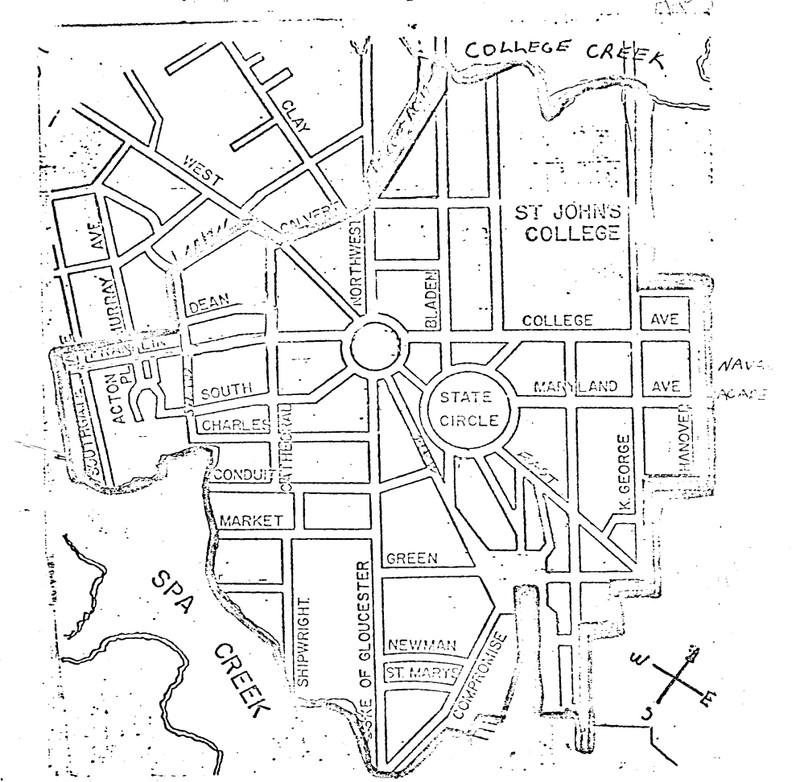Annapolis Historic District
Introduction
Text-to-speech Audio
The Annapolis Historic Landmark District includes the oldest part of the City of Annapolis, founded in 1649, around which the commercial, industrial, and residential areas developed and expanded from the mid-seventeenth century through the beginning of the twentieth century. Designated as a National Historic Landmark District in 1965, it was added to the National Register of Historic Places the following year. In 1984, the Annapolis Historic District was further expanded geographically. The architectural styles reflected within this district include Colonial, Early Republic, Georgian, and Victorian, among others. As noted on the nomination form for the National Register of Historic Places, the Annapolis Historic District is also referred to as the Colonial Annapolis Historic District, although the architecture represented includes a range of design styles from different eras.
Images
Historic photo of Annapolis, 1969

William Paca House & Garden, one of the historic properties in the historic district

Map of Annapolis Historic District

Backstory and Context
Text-to-speech Audio
The City of Annapolis was first laid out on a grid plan in a style of urban planning that was already popular in Europe. The location for the State House was selected by identifying the highest and most commanding position within the city, which overlooked the harbor. A large, public circle (528 feet in diameter) was then designed and constructed for the location of the State House, along with a nearby smaller circle (340 feet in diameter), where a church was built. A major focal point in what eventually became the Annapolis Historic District, the Maryland State House is an eighteenth-century brick edifice with a wooden dome in the shape of a polygon. Located on State Circle, the State House is also a National Historic Landmark in its own right.
Extending outward from the State Circle and the Church Circle, a radial system of public streets was planned and constructed. In the late seventeenth and early eighteenth centuries, the City of Annapolis grew slowly during the years after its founding in 1649. This was due in part to the small size of the harbor, which initially limited the growth and development of commerce. By the time of the American Revolution, however, the City of Annapolis had become a prominent area for culture and politics, with the steady increase of commerce.
On a national level, the City of Annapolis gained attention while serving as the nation's capital between 1783 and 1784. The Continental Congress met at the State House to ratify the Treaty of Paris (signed in Paris in 1783 and ratified in Annapolis in 1784), marking the conclusion of the Revolutionary War between the U.S. and Britain. In addition, the State House was the location where George Washington resigned as the Commander in Chief of the Continental Army. In 1786, the State House served as the location for the Annapolis Convention, which resulted in the Constitutional Convention being held in Philadelphia the following year. Also noteworthy, four signatories to the Declaration of Independence were residents of Annapolis (William Paca, Samuel Chase, Charles Carroll, and Thomas Stone). Their historic homes have each been preserved for visitation by the public. The William Paca House & Garden is located close to the State House in the historic district.
When Baltimore became Maryland's first official Port of Entry in 1789, the City of Annapolis began to decline in relative importance. Nevertheless, Annapolis continued to serve as the state capital of Maryland throughout the nineteenth and twentieth centuries. The founding of the U.S. Naval Academy in 1845 once again boosted the national profile of the city. The Naval Academy is located along the eastern boundary of the Annapolis Historic District, which was designated as a National Historic Landmark district in 1966. This historic district includes a range of architectural styles spanning over two and a half centuries, from the Colonial period to the early twentieth century. For instance, the Shiplap House was built around 1715 to serve as a tavern, and it is one of the oldest surviving properties in the historic district.
Sources
Colonial Annapolis Historic District (Nomination Form), National Register of Historic Places. Accessed January 16th 2022. https://mht.maryland.gov/secure/medusa/PDF/NR_PDFs/NR-8.pdf.
Colonial Annapolis Historic District, Wayside Inn. Accessed January 16th 2022. https://www.waysideinnmd.com/blog/colonial-annapolis-historic-district/.
Annapolis Historic District, Department of Planning, Maryland Historic Trust. Accessed January 23rd 2022. https://mht.maryland.gov/nr/NRDetail.aspx?NRID=837&COUNTY=Anne%20Arundel&FROM=NRCountyList.aspx.
The Confederation Congress’s Ratification of the “Treaty of Paris”: January 14, 1784, History House. Accessed January 23rd 2022. https://history.house.gov/Historical-Highlights/1700s/The-Continental-Congress-s-ratification-of-the-%E2%80%9CTreaty-of-Paris%E2%80%9D/.
Building in the Fourth Century, Annapolis Historic Preservation Commission. Accessed January 23rd 2022. https://www.annapolis.gov/DocumentCenter/View/2157/Historic-District-Design-Manual-PDF.
Maryland Historical Trust
William Paca House & Garden
National Register of Historic Places Nomination Form
